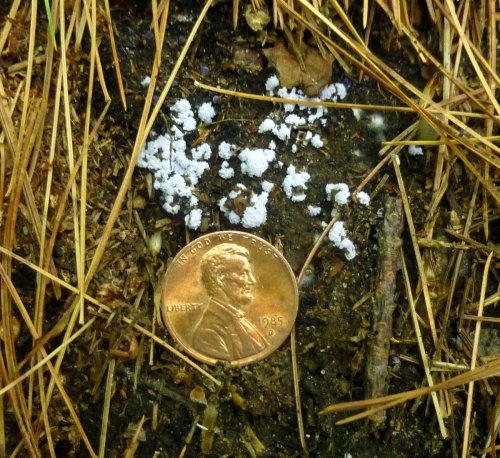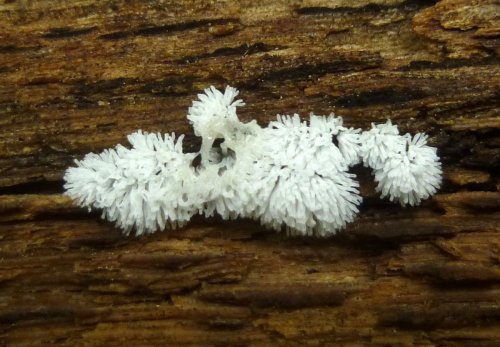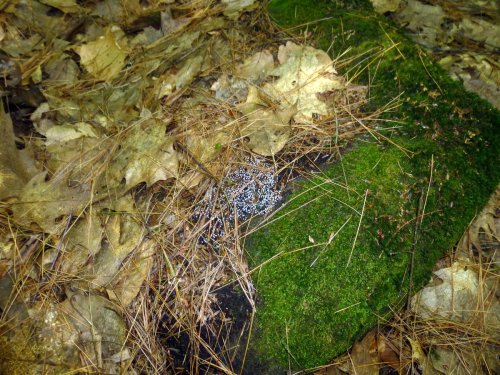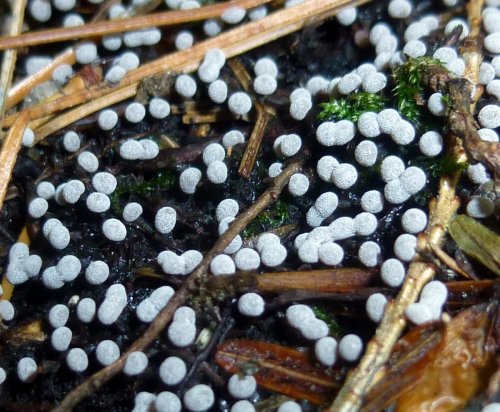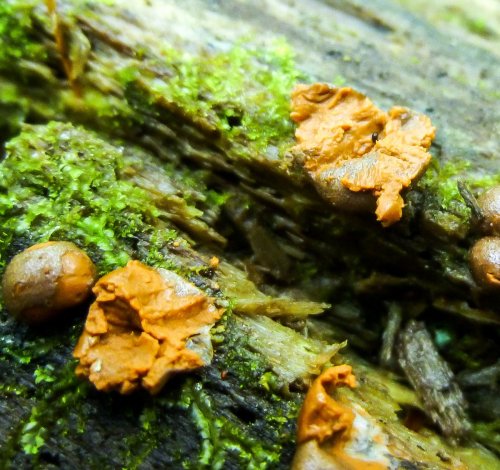We haven’t had much rain here this summer but all it takes is a thundershower, a good hot day and plenty of humidity to get slime molds on the move. And they really do move; through a process called cytoplasmic streaming slime molds can reach speeds of up to 1.35 mm per second, which is the fastest rate recorded for any micro-organism. Scarcity of food is what drives them on, always searching for bacteria and yeasts to feed on. As this photo shows slime mold plasmodium is a mass of glistening vein-like material (actually a single-celled amoeba) that creeps across dead leaves, wood, or soil. I think this might be the many-headed slime (Physarum polycephalum.)
I think this might also be the many headed slime (Physarum polycephalum,) even though it looks quite different than the previous example. When slime molds run out of food and come together into a mass like that pictured above, individual cells change their shape and can form stalks that are capped by fruiting bodies. A fruiting body can look like a jellybean or sphere, or can sometimes resemble blackberries, hair, dripping wax, and just about any other shape imaginable. The fruiting bodies produce spores that are borne on the wind and which will create new slime molds.
How big are slime molds? It varies, but tiny is usually a good description. I always carry my glasses and a loupe when I’m looking for them.
Some slime molds can grow big enough to be seen without too much difficulty. When the weather is right I look for what appear to be white or colored smudges on logs, leaves, or even mossy stones. Slime molds seem to grow on just about anything; there is even a photo online of one engulfing a beer can that was left out on a rock. They almost always grow on the side away from the sun because they don’t want to dry out. This one was growing on the top of a well-rotted log and that tells me that this log doesn’t see much sunlight.
If you want to photograph slime molds you’d better have a macro lens. What is seen in this photo wouldn’t have even covered Abe Lincoln’s head on a penny. I think it might be white finger slime (Ceratiomyxa fruticulosa, variety fruticulosa.) Identifying slime molds can be tricky, but most good mushroom books will include a section on them and there are a few good online resources as well.
The secret to finding slime molds is to walk very slowly and keep your eyes to the ground, scanning right and left as you go. I almost walked right by this one growing on a mossy boulder. Comparing it to the leaves and pine needles shows how small it was.
Looking through a macro lens shows the individual bodies of the slime mold on the stone in the previous photo. I’ve never seen this one but I think it might be Didymium iridis. If it is each tiny body grows on top of a hair thin black stalk. Calcium carbonate crystals give the fruiting bodies a light bluish, powdery appearance.
This organism has me completely baffled. I first saw one last year and it reminded me of a mass of tangled fishing line. This year I stumbled onto a spot where many of them grew in the leaf litter on the forest floor. Each mass was about pear size.
This is a closer look at the whatever-it-is in the previous photo. I don’t know if it’s a slime mold or fungus and haven’t been able to find a photo or description of anything similar. I keep forgetting to feel it and tug on one of the many threads.
Wolf’s milk slime mold (Lycogala epidendrum) starts out as tiny pink globules but as they age and become more like what we see in the above photo the globules look more like small puffballs growing on a log.
I think there are actually two slime molds in this photo. The two small black-brown shiny spheres could be Trichia decipiens, which are often found mixed in with other slime molds.
Wolf’s milk slime mold is also called toothpaste slime and that’s because there is a pinkish orange material inside each globule with the consistency of toothpaste. It can also have a more liquid consistency, which is usually the way I find it. As it ages it will turn into a mass of brown powdery spores.
One of the most common slime molds is the scrambled egg slime (Fuligo septica.) It gets quite big and will grow in full sun on wood mulch or chips, so it is easily seen and is often people’s first introduction to slime molds. Fuligo also septica produces the largest spore-producing structure of any known slime mold.
I wasn’t sure if this was a slime mold or not but I found some similar examples on line that said they were Lindbladia tubulina slime mold, which apparently has no common name. This one was somewhere between gunmetal gray and black, and about as big as a pear. It is described as cushion shaped and likes to grow on dead conifers, just as this one was doing.
A close look at the surface of Lindbladia tubulina shows thousands of tiny shiny spheres. The outside was crusty but inside where the spores are produced is said to be spongy and yellow or olive green. This type of surface is said to be bullate, which means “covered with rounded swellings like blisters.”
I don’t really know if this was a slime mold, fungus, or something else but since blue is my favorite color I was happy to see it. It was about as big as a penny.
Nature will bear the closest inspection. She invites us to lay our eye level with her smallest leaf, and take an insect view of its plain. ~Henry David Thoreau
Thanks for stopping in.


